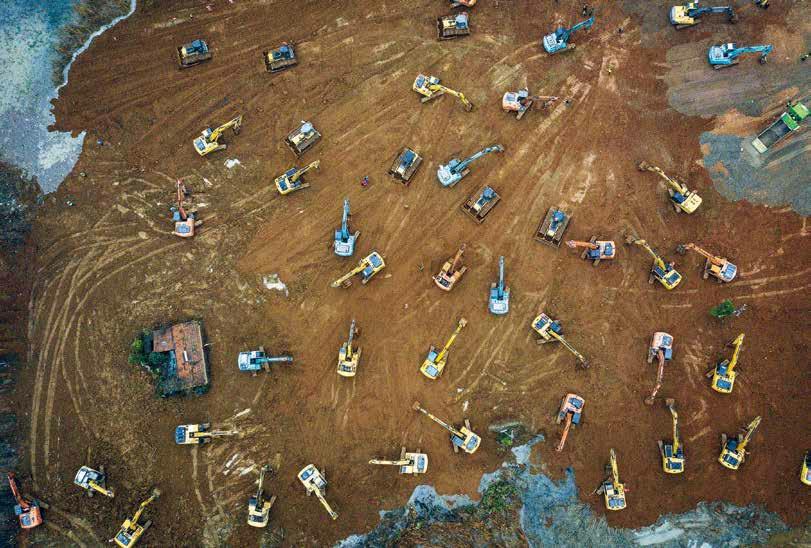Major Milestones in 2020
2021-02-24byLiZhuoxi
by Li Zhuoxi



No one doubts that 2020 was a landmark year for Chinas national development.
The Chinese people united to fight the epidemic. Chinas opening up is becoming wider and wider, and mutually beneficial cooperation with other countries is making overcoming difficulties easier. Major breakthroughs have been made in the research of cutting-edge technologies. The mission to eradicate absolute poverty was completed as scheduled, and decisive achievements were made in completing the building of a moderately prosperous society in all respects. The Fifth Plenary Session of the 19th Communist Party of China (CPC) Central Committee drew a magnificent blueprint for Chinas development over the next five years and even longer. Rapid correction of economic indicators will help the world economy recover and make great contributions to building a community with a shared future for humanity.
Change-5 Mission
The successful completion of the Change-5 lunar exploration project represented a milestone leap in the development of Chinas aerospace industry, evidencing Chinas ability to make round trips between the earth and the moon. It was a perfect ending of the three-step plan of “circumnavigation, landing and return” and laid a solid foundation for Chinas future lunar and planetary exploration.
Chinas lunar exploration is becoming more and more open. We are engaging in more cooperation with international partners. The targets of Chinas space exploration have shifted from the moon to planets, and the development method has changed from independent to comprehensive opening up and cooperation.
Pei Zhaoyu, spokesperson for the Change-5 Mission
BeiDou Satellites
The BeiDou satellite navigation system is a global system independently constructed and operated by China. It is also the third mature satellite navigation system after GPS and GLONASS. BeiDou is accelerating its global integration. More than half of all countries in the world have used the BeiDou system. In recent years, BeiDou, GPS, Galileo, and GLONASS have established a cooperation mechanism based on compatible consensus, and the prospects for jointly building a satellite cluster with compatible use and higher precision have become more promising.
The four major systems do not have a competitive relationship as some think. They are working together to provide global users with more accurate and reliable positioning and navigation services and promote world interconnectivity.
Ran Chengqi, director of China Satellite Navigation System Management Office
Grand Canal Culture
With a history of more than 2,500 years, the Grand Canal is the worlds oldest and longest man-made waterway. It is not only a milestone in world history of canal construction, but also represents an everlasting cultural gene of the Chinese nation. Although it is no longer used as a transport artery linking northern and southern China, the canals historical and cultural implications continue growing with each passing day.
The Great Wall and the Grand Canal are two icons of traditional Chinese culture. With an active and enterprising spirit, the Grand Canal significantly accelerated economic development and cultural exchange in China.
Gu Yucai, deputy director of the National Cultural Heritage Administration of China
5G Technology
In addition to livestreaming hospital construction during the epidemic, 5G was also applied to multiple scenarios such as remote medical consultation and temperature screening. Since China officially started licensing in 2019, 5G has been commercially available for more than a year. On December 15, 2020, the Ministry of Industry and Information Technology of China claimed that the country had built the worlds largest 5G network, with more than 718,000 base stations built and co-construction and sharing of 330,000 base stations.
5G is stimulating technological progress in the telecommunications industry, fostering new momentum for transformation and upgrading of the economy, and creating new life paradigms at the social level.
Liu Duo, president of China Academy of Information and Communications Technology
Dual Circulation
On May 14, 2020, a meeting of the Standing Committee of the Political Bureau of the CPC Central Committee first proposed “further deepening supply-side structural reform and leveraging the advantages of Chinas super-large market and domestic demand potential to create a new development pattern where domestic and foreign markets can boost each other.”Constructing a new development pattern based on “dual circulation” is a major strategic deployment to boost Chinas open economy to a higher level in the context of significant changes in the domestic and international environment.
The new development pattern is based on the domestic economic cycle. It wont lead to less opening up, but more resolute and wider expansion of the fields, scope, and depth of Chinas opening up, so domestic circulation and international circulation can mutually grow.
Yang Weimin, president of China Development Planning Research Institute of Tsinghua University
Fifth Plenary Session of the 19th CPC Central Committee
From October 26 to 29, 2020, the Fifth Plenary Session of the 19th CPC Central Committee was held in Beijing. The meeting focused on discussing proposals for Chinas 14th Five-Year Plan (2021-2025) and 2035 long-term goals, drawing a blueprint for the countrys future development.
This plenary session is extraordinarily significant. The 14th Five-Year Plan is the first of its kind to launch a new 30-year journey under the premise of completing the building of a moderately prosperous society in all respects.
Li Junru, former vice president of the Party School of the CPC Central Committee
Shenzhen at 40
A landmark and role model for Chinas reform and opening up, Shenzhen rose from a small fishing village to become an international metropolis in only a few decades. The city is setting sail again by promoting reform and opening up from a higher starting point and building a pilot demonstration zone for socialism with Chinese characteristics.
Tencents journey in Shenzhen over the past 22 years has left us convinced that as long as its reform and opening up continues and the spirit of the special economic zone flourishes, Shenzhen will continue thriving, and enterprises in the city will continue developing and growing.
Pony Ma, chairman and CEO of Tencent
COVID-19 Vaccine
On October 8, 2020, China signed an agreement with the Global Alliance for Vaccines and Immunization to formally join the “COVID-19 Vaccine Global Access”(COVAX). It was an important step for China to uphold the vision to build a community of common health for mankind and fulfill its commitment to promote Chinesedeveloped vaccines as a global public good. China solemnly promised that after Chinas vaccine research and development is completed, the results would be provided as a global public good, with priority given to developing countries.
China is taking this concrete step to ensure equitable distribution of vaccines, especially to developing countries, and hopes more capable countries will also join and support COVAX.
Hua Chunyin, spokesperson of Chinas Ministry of Foreign Affairs
Victory over Poverty
China is the largest developing country in the world and has always been an active advocate and a powerful promoter of global poverty reduction. In 2020, the rural poor population in the country was entirely lifted out of poverty at current Chinese standards. This marks that China achieved the poverty reduction goals of the United Nations 2030 Agenda for Sustainable Development 10 years ahead of schedule, a major contribution to global poverty reduction.
Over the past 40-plus years, China has introduced effective poverty alleviation policies while its economy was developing rapidly, and mobilized all social forces to participate in poverty alleviation. More than 700 million Chinese people have been lifted out of poverty, contributing more than 70 percent of the worlds poverty reduction.
James Lynch, director of the East Asia Department of the Asian Development Bank
Third CIIE
The total exhibition area of the 3rd China International Import Expo (CIIE) was about 360,000 square meters, nearly 30,000 square meters larger than the previous year. Compared to the 2019 expo, Global Top 500 companies and leaders of specific sectors returned at an 80 percent clip. On a one-year basis, the cumulative intention of transaction was US$72.62 billion, an increase of 2.1 percent over the previous session. The 3rd CIIE was held as scheduled in a special period and under a special international environment, reflecting Chinas sincere desire to share market opportunities with the world and promote recovery of the global economy.
The pandemic has made a big impact on the economy of China and the world. A platform like the CIIE is important to help economic recovery and restore confidence.
Kamran Vossoughi, president and CEO of Michelin Greater China
New Measurement of Mount Qomolangma
On December 8, 2020, Chinese President Xi Jinping and Nepalese President Bidya Devi Bhandari exchanged letters, jointly announcing the new official height of Mount Qomolangma, revising its elevation as 8,848.86 meters. As two neighboring countries separated by the mountain, China and Nepal have not only conducted joint missions to climb to the top of Mount Qomolangma, but have also cooperated on environmental protection in the mountainous area. Friendship between the two countries has produced positive results for Mount Qomolangma. China and Nepal jointly announcing the official height of the mountain was a key global milestone.
This survey project involves not only measuring the height of Mount Qomolangma, but also obtaining extensive data in realms such as meteorology and gravity which will be of great scientific significance for ecological and environmental protection.
Li Guopeng, front-line commander of the Mount Qomolangma elevation survey mission